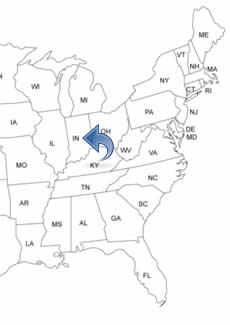INDIANA PEOPLE SEARCH!
- ✔ Contact Info
- ✔ Phone Numbers
- ✔ Criminal Records
- ✔ Income Info
- ✔ Neighbors
- ✔ People's Age
- ✔ Property Ownership
- ✔ And Much More
Fort Wayne, Indiana
Fort Wayne is located in the northeastern part of Indiana and is the second largest city in the U.S. State of Indiana. Fort Wayne is a metropolitan city with a small community feel. The city has many historical buildings that usually offer regular tours. Visitors are drawn to the city's many attractions.
Every month you can visit a festival in the city, and the city offers over 600 restaurants to eat in. The city is a three-time All American City Award winner.
To See And To Do In Fort Wayne
- Fort Wayne Museum of Art
- The Fort Wayne History Center
- The Embassy Theater
- Foellinger-Freimann Botanical Conservatory
- Science Central
- Shopping At Jefferson Pointe
History Of Fort Wayne - Timeline
Around 1680, European settlers, fur traders, established a trading post in the area. In 1697, the French built a fort on the site. In 1704, a fortified trading post was built. In 1750, Fort Miami was built. In 1763, it was burned to the ground during Pontiac’s Rebellion. In 1794, Fort Wayne was built. The American fort was built in honor of General "Mad" Anthony Wayne.
In 1805, more farmers and traders settled in the area. In 1812, the fort was under siege by American Indian. They attacked the fort and burned the homes of the surrounding village. In 1813, it was now no longer a village but more like a town that was growing around the fort and another fort was built in 1816.
In 1819, the father of Fort Wayne's roads and railroads, Samuel Hanna, arrived. He built a grist mill, called Beaver's mill, and a trading post and become the "builder of the city" and Fort Wayne's most worthy and respected citizens. In 1824 he helped to designate Fort Wayne as county seat.
In 1829, the town was incorporated. In 1832, the construction of the Wabash & Erie Canal began. In 1840, Fort Wayne was incorporated as a City. In 1842, the first commercial industrial enterprise was constructed in Fort Wayne by Jesse L. Williams and Allen Hamilton.
In 1844, Samuel Hanna built a house on East Lewis Street. Also in 1844 the Hedekin House was built that year on Barr Street. In 1846, the railroad came, and the Concordia Theological Seminary was founded. In the 1850s several rail lines ran through the city, allowing the industry to flourish.
In 1853, the Brass Foundry and Machine Company was founded. The company was once the world's largest manufacturer of railroad car wheels. In 1865, the Trinity Episcopal Church was built. In 1871, Dr. Theodore Horton, who had founded Horton Manufacturing Company, introduced a hand-operated washing machine. Later his company manufactured the first electrically powered washing machine.
In 1883, the first-night baseball game in the US took place in the city. In 1889, the Saint Paul's Evangelical Lutheran Church was completed. The Wayne Knitting Mills opened in 1891. In 1893, the Old City Hall building in downtown was built. In 1895, the Elekron Building was completed and the Allen County Public Library opened in the Old City Hall building.
In 1900, more than 45,000 people lived in the city. In 1902, the Allen County Courthouse was completed. The Great Flood of 1913 left six dead and 15,000 homeless. Fort Wayne continued to grow even during the depression years, with Farnsworth Television, Essex Wire, Zollner Piston, Central Soya, Holsum Bakery, and a number of other companies beginning business.
In 1928, the Embassy Theatre opened. Today it is the home of the Fort Wayne Philharmonic Orchestra. In 1930, the Lincoln Tower was completed. The Great Flood of 1982 forced 9,000 residents to evacuate and over 2,000 residences and businesses were damaged by floodwaters. In 2009, the baseball stadium "Parkview Field" opened.

